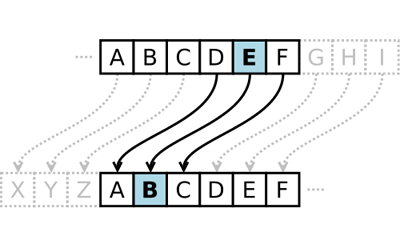
Caesar mainly applied the cipher to sensitive military messages, mostly commonly using a simple +3 cipher which translated A’s to D’s, B’s to E’s, etc. It may seem tough to break, but with this tool you'll see the message in no time! History of the Caesar Cipherĭeveloped around 100 BC, the Caesar Cipher is named after Julius Caesar, who used it often during his two-year reign. To make it harder to solve, some cryptologists combine the Cipher with other encryption tools. This word could then be decrypted by anyone who knew the original encryption method of a +3 Caesar Cipher, who could reverse the cipher by translating all letters back three steps: F to C, L to I, and so on.īecause the Cipher is considered such a basic decrypter in modern times, it can be easy to break. The final encrypted word would read FLSKHU. For instance, if you were encrypting the word ‘CIPHER’ with a +3 shift, the letter C would become the letter F the letter I would become the letter L and so on for each letter. One of the oldest and simplest ciphers, the Caesar Cipher is a substitution cipher, which means each letter is shifted a certain number of places down the alphabet. Make sure you enter the alphabet in the correct order, or the cipher shift won’t be encoded properly. If you’re working with an alphabet other than the standard English alphabet, enter it in the ‘custom alphabet’ box. If you’re trying to decrypt a message and you don’t know what the shift is, you can check the ‘brute force’ box, which will show you all the possible decryptions of your message. For instance, a shift of -1 will change all A’s to Z’s, all Z’s to Y’s, etc. In contrast, a negative shift will move letters to the left.

For instance, a shift of +1 will change all A’s to B’s, all B’s to C’s, and so on. A positive number corresponds to a right shift. In the appropriate box, choose how many steps you’d like to shift each letter. On the other hand, if you’d like to encode a message, enter the plaintext you’d like encrypted into the box on the right. If you’re trying to decode encrypted text, type the message into the box on the left.
#Caesar cipher decoder how to
How to Use The Caesar Cipher Decoder Tool Whether you’re a long-time lover of cryptography looking to speed up the encryption process or just learning how to create coded messages, this tool can help you easily and efficiently encode and decode cipher text. Second, you repeat the same check a couple different if statements which is a sign you can likely break that out into a separate function so you only have to write the logic once.Welcome to our Caesar Cipher Decoder tool! This tool can help you decode messages sent with a simple Caesar Cipher, or encode your messages to send to your friends. package mainįunc caesar(text string, key int) string
#Caesar cipher decoder code
Here is a revised version of your code that addresses my code review issues. Your cipher function versus reasonably efficient package caesar functions: name time/opĪmongst other things, your frequent use of immutable string concatenation ( +=) is expensive. Your cipher implementation function is orders of magnitude too expensive. THE QUI&K %ROWN FOX JUMPS OVER THE L$ZY DOG QEB NRFZH YOLTK CLU GRJMP LSBO QEB IXWV ALD Output: THE QUICK BROWN FOX JUMPS OVER THE LAZY DOG Var cipherText = `QEB NRFZH YOLTK CLU GRJMP LSBO QEB IXWV ALD`įmt.Println(cipher(cipher(plainText, +1, key), -1, key))

Var plainText = `THE QUICK BROWN FOX JUMPS OVER THE LAZY DOG`

For example, it fails the Wikipedia: Caesar cipher example: Your cipher implementation function is not correct. With the encryption inverse function form plain = caesar.Decrypt(caesar.Encrypt(plain, key), key) The general shape of the Caesar cipher is an encryption inverse function.įor the Caesar cipher, an encryption package API, package caesarįunc Encrypt(plain string, key int) stringįunc Decrypt(cipher string, key int) string Your API does not appear to be a thoughtful design: func cipher(text string, choice int, shift int) stringĪ good API design follows the shape of the problem, not the implementation.


 0 kommentar(er)
0 kommentar(er)
